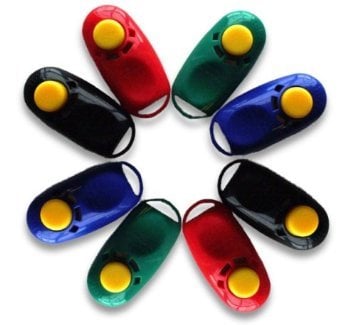
When someone refers to clicker training, we usually think of dogs. However, did you know cats are also responsive to clicker training? In this article, you are going to learn what clicker training is, how it can be helpful to your cat, and how to start if you have decided to give clicker training a chance.
What clicker training is and how it works
Clicker training is a type of training that uses a tool called a clicker, so named due to a simple “click” sound it makes every time you press its button. We should also mention that the “click” is made mechanically, and no batteries are required.
But what is the magic about the clicking sound, and how does the clicker work in cat training?
Cats, and most other animals, learn by association; this type of learning is often referred to as “operant conditioning.” In simple terms, it means that cats learn from their experience. For example, if your cat is scratching a post instead of the carpet, you may give him a treat. Do it frequently, and your cat will be using the post more often, just to get the food.
Here’s how “normal” training works:
- The cat exhibits the desired behavior.
- You give the cat a treat within a few seconds.
- The cat learns to repeat the desired behavior (or avoid the undesired behavior) to receive the treat.
It works similarly for teaching a trick or for training your cat to behave well. It even works to reinforce a bad behavior, such as when owners feed their cat if he is meowing at night, just to get him to be quiet. But, in our case, we want to give our cats a reward for appropriate behavior, and, if the reward is given consistently, the cat will want to behave well to get it.
The clicker helps bridge the gap between the desired behavior and the reward you provide
For training to be effective, the challenge is to give the reward within a few seconds after the desired behavior. You can’t give a treat to your cat for using the litter box a few minutes after he leaves the box. He won’t have a clue why the treat appeared, and he actually wouldn’t care as long as the treat is there.
Unfortunately, providing a treat within seconds after the desired behavior is not easy. And this is where the clicker comes in.
Here’s how clicker training works:
- The cat is trained to understand that clicker = treat.
- The cat exhibits the desired behavior.
- The clicker is sounded instantly.
- The treat is provided soon after the clicker.
- The cat learns to repeat the desired behavior to hear the “click” (because he knows the treat is on its way).
This involves more steps compared to the steps in “normal” training, and the steps are harder to understand. So why on Earth do you need the clicker?
We already mentioned that it’s not easy to provide a reward moments after your cat performs well. You don’t carry treats wherever you go to issue one whenever your cat decides to use a scratching post. In addition, some training types require an immediate reward, without refocusing attention to the treat itself. The clicker lets you do that.
How to get started with clicker training for cats
The first step in clicker training, whether you are training dogs, cats, birds, or dolphins, is always about creating associations between the clicking sound and the reward. Your cat has to know that “click” means food.
Making this happen involves a simple and pleasant task for you and your cat:
- Get your cat’s attention.
- Click.
- Give a reward, immediately.
- Repeat.
In the beginning, do this as long as your cat is able to hold his attention. During this process, remember that you will be treating your cat quite often, probably more than ten times in every session, and several sessions per day. That’s a lot of food. So, do your calculations and subtract this amount from your cat’s daily food intake. You don’t want him to get fat.
Use clicker training to achieve good behavior from your cat
After a while, test your cat. Occasionally, sound a clicker without getting his attention beforehand. If he runs to you, or looks at you at least, and is waiting for a treat, you have done well. The association between clicker and food is still weak, but you can start implementing it in training.
We are not going to give an example of a specific problem to solve or trick to be taught, because clicker training works similarly in all cases.
So, when your cat performs a trick, such as “sit,” or behaves well, you click a clicker. Your cat’s attention must now be on you, and he’s expecting a reward in the form of a treat. Provide it. However, at this point, your cat still does not know that the “click” was because of his action.
Clicker training must be consistent
Your task is to repeat, repeat, and repeat. And then again. Depending on the individual cat, the more often you repeat, the sooner your cat will understand that the good behavior results in a “click.” And, as he already knows that “click” means food, he’ll be wanting to repeat this behavior more often to hear that “click.”
A good resource for getting you started is a book “Clicker Training for Cats” by Karen Pryor.
